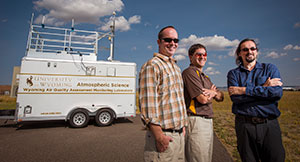UW Research Scientist Makes Important Contribution to Use of POD Sampler
Published March 23, 2021

A University of Wyoming senior research scientist has made important field contributions in the use of the POD sampler, an instrument used to accurately sample pollution levels.
Robert Field, in UW’s Department of Atmospheric Science, has collaborated with Pascual Perez Ballesta, the inventor of the POD sampler, on volatile organic compounds (VOCs) measurement methodology validation research since the 1990s. At that time, Field was part of a small team establishing a state-of-the-art national hydrocarbon network in the United Kingdom. Procedures developed by Field remain, to this day, at the core of automated data handling to ensure data quality.
Their work will be highlighted in a webinar, titled “Learn New Methods to Enhance Quantitative Workflows for VOC Analysis,” Tuesday (today) at 11 a.m. MDT. Separation Science, in collaboration with Markes International, will make the presentation. Ballesta, from the European Reference Laboratory of Air Pollution, and Hannah Calder, environmental air market development manager for Markes International, are the presenters. Markes, an international leader in VOC analysis instrumentation, will market the sampler globally.
To register for the webinar, go to https://webinar.sepscience.com/form/introducing-the-pod-sampler-the-latest-development-in-radial-diffusive-sampling-for-vocs.
Field assisted Ballesta with the preparation of the webinar presentation. Field, along with UW, is acknowledged verbally in the webinar recording and on one of the presentation slides.
The POD sampler is next-generation technology in radial diffusive sampling, a diffusive sampling that has a radial membrane for uptake of pollutants. This increases the surface area and responsiveness to changes in environmental conditions. The POD sampler simply collects pollutants by diffusion and may collect pollutants over a period of hours to months. The time period depends on the situation being examined.
“I performed the first field intercomparison in the Upper Green River Basin,” Field says. “I deployed PODs and my canister sampling system. I performed analysis of canisters back in my lab on campus, and that was compared to independent analysis of the POD samplers in Europe. This was one of a few different tests led by the inventor.”
The POD sampler can be placed almost anywhere and has been used to measure trace levels of VOCs in Antarctica; to define personal exposure of commuters; and estimate emission profiles from oil and gas extraction activities, Field says. Additionally, the POD sampler is well suited to fence-line monitoring and can help government agencies, developers and citizens accurately sample pollution levels.
Field also has performed field deployments of the POD samplers in different oil and gas basins in Wyoming and Utah.
“In this work, I set the samplers in situations to enable analysis of VOC to determine emission source profiles,” Field explains. “These are used to determine the contribution of different emission sources to ambient air pollution.”
This research has really been “a long haul with field work since 2013,” he says.
During this time, Field’s efforts were supported by a $5,000 seed grant from UW’s Center for Global Studies; by undergraduate research interns from the UW School of Energy Resources; and by Rachel Edie, a UW doctoral student in atmospheric science.
“I have a lot of groups and people in Wyoming to thank for their support,” Field says. “I had to be quite resourceful and piggyback this work onto research activities funded by other agencies, including the Wyoming Bureau of Land Management (BLM).”
“The support and expertise of Dr. Field has been critical for the implementation of the POD sampler, and his practical vision and scientific enthusiasm have always served as a collaborative bridge for tackling new projects,” Ballesta says.
The sampler will improve the quality of VOC sampling. While the next step is to complete the publication of a new diffusion model to extend the range of the sampler, the current POD sampler is now the cheapest and easiest approach for measuring air toxics, such as benzene, Field says.
Field is one of four co-authors of a paper on the subject of the POD sampler, which was published in Analytica Chimica Acta.

